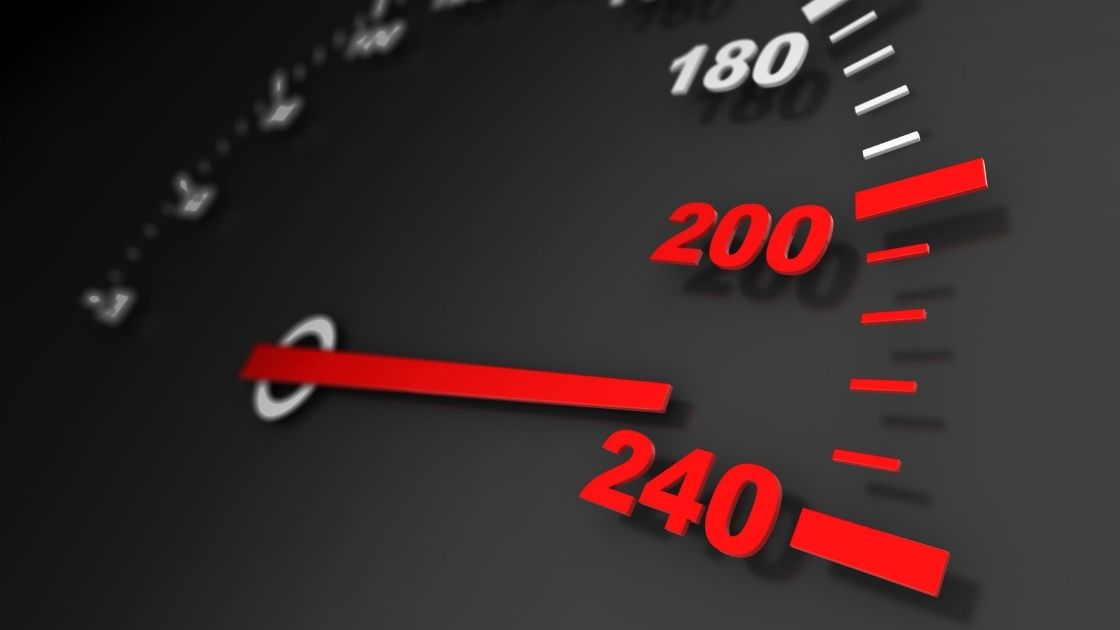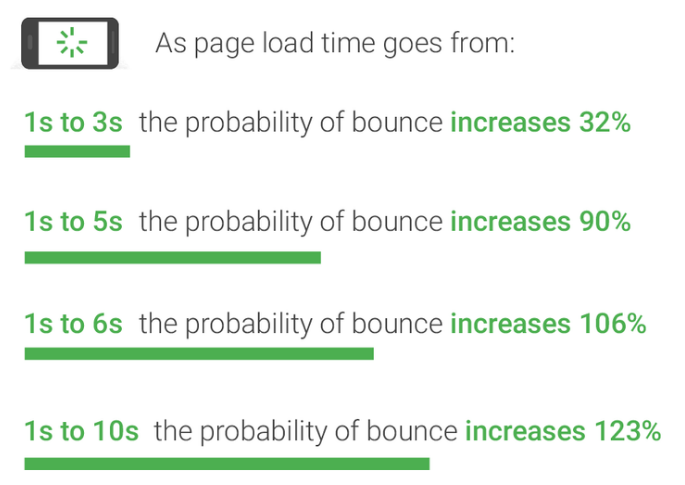Keeping your WordPress site Page Speed can be frustrating and, ironically, take up a lot of your time. But the faster your site loads, the more likely you are to keep users on the page and convert them. Thankfully, there are some useful tricks and tools that can help you get things moving much faster.
If you play your cards right, you’ll be amazed at how much of a difference optimizations to your site can make. In this guide, we’ll explain what you need to know about WordPress page loading times — why they’re important, what slows them down, and how you can make yours better.
Why is Loading Speed Important?
Most websites — especially eCommerce sites — only perform well if they load quickly. According to research by ThinkWithGoogle, every extra second of load time increases the likelihood that you’ll lose your site visitor: Seconds
Additional Google research found that 53% of mobile site visitors leave a page if it takes three seconds or more to load.
The Importance Of Loading Speed
- Improve SEO Rankings
Google and other search engines use a range of factors to determine where your website will appear in organic search rankings
One of the most important elements in Google’s calculations is mobile loading speed. Google even provides a tool to help website owners test their site’s speed on mobile devices.
(This is not an accident.) Beyond a direct impact on your search ranking, slow speeds can also hurt your site indirectly.
For example, as we mentioned already, slow loading speeds can contribute to a higher bounce rate, or more people leaving your site without engaging. But when search engines see that users leave your site before they interact with it, your rankings can fall even further.
- Increase Conversion Rates
As mentioned prior, your conversion rates are dramatically impacted by the speed of your site. Making adjustments can make a huge impact.
For example, research by Portent in 2019 found that website conversion rates drop by an average of 4.42% with each additional second of load time (between seconds 0-5). And according to data from Kissmetrics, a one-second delay in page response can reduce conversions by as much as 7%. Which, for an eCommerce site making $100,000 a day, could cost as much as $2.5 million in lost sales every year.
- Boost Landing Page Scores
If you’re running Google Ads that link to a landing page, the speed of that page is taken into account when Google compares your ads with other campaigns competing for the same keywords.
And if your landing page loading times are slow, it can lead to:
• Ads not appearing as often
• Higher cost-per-click (CPC)
• Dissatisfied customers
• Missed opportunities
Why Is Your WordPress Site So Slow?
Slow loading times on WordPress sites usually boil down to the same batch of issues, especially for eCommerce. You’ll want to run speed tests to see how your site is performing (more on that later), but the problems you run into will most likely include some combination of the following five factors…
Reasons For Slow WordPress Sites
- Non-Optimized Images
Your WordPress website doesn’t look like much without images. But if you don’t optimize your images before or during the upload process, your site’s size and loading times will expand faster.
But if you have lots of images on your website that are bigger than 2MB, your WordPress site isn’t going to load very fast, especially on mobile devices.
- Content Delivery Networks
Content delivery networks (CDNs) are an essential tool in the battle against slow-loading pages.
The physical distance between a website’s server and a user’s location can also make pages load more slowly. CDNs virtually shorten that distance by storing a cached version of your site content in multiple geographical locations.
This way, when a user clicks through to your WordPress website or landing page, the content is coming from the closest possible cache, not a central location that might be on the other side of the world.
- Server Response Time
Sometimes, the blame for a slow WordPress site falls on the host.
Less reliable web hosting services might not provide the data bandwidth or processing power your site needs, which means it’ll be next to impossible to fix things on your end. Also, if you’re on a shared or virtual hosting plan, you’re using “common” hosting space that could fluctuate during peak traffic times.
With all that in mind, if your tests show a slow server response, it might be time to upgrade to managed WordPress hosting. A managed solution includes a server and CDNs devoted exclusively to your website, which will create a faster and more secure (and probably more expensive) solution.
- WordPress Themes
A poorly coded third-party WordPress theme can slow down even the best hosting solution and optimized site elements.
If you’re using a prebuilt WordPress theme for your commercial website or eCommerce store, choose one from a trustworthy source that doesn’t have more features than you plan to use. And if possible, enlist your preferred web developers to create a
the theme that only includes what you need to maximize loading times.
- Caching
Each time a visitor accesses a page on your website, it takes time — valuable, precious time — to render on the screen. Enabling caching allows assets on your website to be downloaded to temporary storage space, or “cache,” on a user’s hard drive. Storing
those files locally speed up subsequent page loads.
In other words, caching your site “primes” pages so they can be rendered before a visitor accesses them.
Slow page load times are not limited to these factors alone, but they’re among the most important. Website owners and developers will inevitably encounter these problems when they’re trying to speed up a WordPress site for better performance.If you can identify these issues and address them proactively, your website should see significant performance improvements.
Tools for Checking Page Speed
There are a few different page speed tests that can help you analyze your website’s performance and find areas to improve.
It’s important to test page loading speeds regularly to locate and head off any business-impacting deviations.
Page Speed Tools
Google has several tools for checking loading speeds, as well as related diagnostics for technical issues like mobile-friendly design standards and other important factors.
These include:
1. Website Performance Measurements by Web.dev
2. Test My Site by ThinkWithGoogle
3. Google’s PageSpeed Insights
Use all three to check your website if you are unsure.. Review and address the issues that the tools discover whenever possible.
- JetRails
JetRails is a fast and simple audit for eCommerce and commercial websites. Their test measures the milliseconds it takes for a web browser to receive its first byte of data from your hosting server when a visitor attempts to visit your site.
This metric, known as Time To First Byte (TTFB), is a common shorthand for page loading speed. TTFB often exposes “Achilles heel” of page speed, as it will tell you if your hosting or your website practices are to blame for any load time issues.
- GTMetrix
GTmetrix’s Website Speed Test is another free tool for analyzing page speed. Like the others listed here, GTmetrix can see how your site’s performing, compare it to similar sites and identify opportunities to improve and optimize your loading times.
- Pingdom
The Pingdom Tools Website Speed Test analyzes your site speed from a handful of global servers. This gives you a quick overview of how quickly or slowly your site loads in different parts of the world.
Pingdom also reports on how different on-page and back-end elements, like fonts and redirects, fit into the overall makeup of your particular website.
Tip: Test your loading speeds at regular intervals. You should also double-check page speeds after making changes or updating pages on your website. Page speeds can be impacted by a wide variety of factors and change over time. It’s essential to watch out for any problems, as they could cost you money if they aren’t addressed.
WordPress Plugins For Page Speed
The WordPress Content Management System (CMS) offers thousands of pre-built plugins. Given how popular WordPress is, many of these plugins are used on a mass-adoption scale in websites worldwide.
3 WordPress Plugins
- Image Optimization
Whenever new photos are posted to your website, they should be appropriately compressed and optimized.Remember, most desktop screens aren’t any bigger than 1920px by 1080px, and mobile screens are usually 700px across or less. Given those guidelines, there’s no reason to upload and publish pictures larger than this.
That also leaves more room for error as your team edits and adds to your site content. The image file size is also crucial when you’re optimizing images. You can reduce an image’s dots per inch (DPI), which lowers the overall image quality but is imperceptible
online.
For example, print publications usually require images with 300 DPI, but the standard for images online is just 72 DPI. Image optimization plugins can also help automate the process to reduce the chance of human error.
Lots of popular WordPress image optimization plugins include features like automatic compression and image resizing, including:
1. Semush
2. EWWW Image Optimizer
3. Optimus
4. ShortPixel Image Optimizer
5. Imagify
Depending on your needs — eCommerce products, branding collateral, etc. — you should be able to find an image optimization plugin that meets the needs of your WordPress site.
- Caching
when a visitor accesses your website, various files need to be activated and rendered to display a given page in a browser window. Caching technology speeds up that process by storing pre-rendered copies of pages instead of re-rendering them for every request.
WordPress caching plugins like WP Fastest Cache , W3 Total Cache and Wp Rocket take care of most of these issues automatically. And while there are other cache plugin options to choose from, these three are used in more than one million active
WordPress installations and have more than 2,000 five-star reviews.
- General Optimizers
General or all-in-one speed optimization plugins usually include a range of features designed to get your site loading faster. These include:
1. Minification – Shrinks HTML, JavaScript, and CSS file sizes by removing unnecessary characters like spaces, line breaks, and comments, reducing the amount of data necessary for transfer. You’ll need to upload a new “minified” CSS or stylesheet to your site to implement the new code.
2. GZipping – GZIP file compression tells your server to find all repetitive strings text and replace them with pointers to the first instance of that string. Like minification, this greatly reduces the amount of text and data your website needs for loading. Unlike minification, however, GZIP happens on the server side and doesn’t require extra work on your end.
3. Lazy Load – Lazy load works well for long pages or blogs with long comment threads. This technique defers the loading of images and other on-page content until it becomes visible in the client’s viewport or the page’s ‘onload’ event fires. With this add-on, your page will load primary elements faster and reduce the lag of loading a large page.
Tip: These tools are built to help optimize your WordPress web page elements through automated processes and easy-to-enable features. Ideally, these plugins will save you lots of time and effort. For instance, it can be time-consuming to manually minify your website coding without a plugin.*
*Note: If your web host uses Cloudflare, many of these tactics are available without additional WordPress plugins.
Again, these are examples of popular and regularly updated WordPress plugins that can help you improve your WordPress loading speeds. There are dozens of other plugins, however, that can speed up a WordPress site. Some might meet your needs better than others.
Choosing The Right WordPress Optimization Plugin
Not all WordPress plugins are created equal. (In fact, some aren’t even created well.) If you’re on the hunt for a plugin that matches your particular needs,
consider the following:
- Reviews
When choosing WordPress plugins, consider both the star rating and the number of reviews. A five-star rating doesn’t mean much
if there are only one or two total reviews.
- Versions
Just because a page speed optimization plugin looks useful doesn’t mean that it’s being maintained and kept up to date. Review how recently the plugin was updated and what versions of WordPress it’s compatible with.
- Active Installs
If millions of WordPress websites are using a plugin, it doesn’t automatically mean that it’s the best thing out there. However, it does increase the likelihood that it’s been tested and improved through real-world experience.
- Conflicts
Too many plugins can lead to conflicting features and functions on your website, which can cause loading errors and other issues.
Remember When You Choose a Plugin – You’ll need to choose between one of two paths to avoid these problems. You can use single-purpose optimization plugins for specific tasks, like minifying JavaScript or caching files. Or you can integrate an all-in-
one WordPress page speed plugin that solves your needs from one central hub.
That said, If you already have external systems helping you optimize images, cache files, or minify files, layering extra plugins onto your WordPress account might be more of a hindrance than a help.
Check more: How to Use Keywords to Optimize Your Blog Posts
Check more: 24 Ways to Find Customers Online
Check more: How To Build A Web 2.0 Private Blog Network
Check more: Beginner Guide to Conversion Rate Optimization (CRO)
Conclusion
If you’re frustrated with your website, remember that site speed issues are common, and lots of businesses don’t even know they have these problems. It’s also important to remember that you have all the tools and resources to speed up your site faster.
The thing to keep up daily :
- Scan and test your WordPress website regularly.
- Track your loading speeds and identify bottlenecks that slow down your site.
- Work with your team to develop best practices that keep your pages running as fast as possible.
In the end, maintaining a fast-loading WordPress website is one part science, one part art. Keep it up and watch those engagement and conversion rates climb!
Consider Following a Course ?
With Lifetime Access ?
We have been the number 1# platform for delivering most demanding course. Becoming Lifetime Member , You will receive all the Premium content For FREE

Consider Following a Course ? With Lifetime Access ?
We have been the number 1# platform for delivering most demanding course. Becoming Lifetime Member , You will receive all the Premium content For FREE




